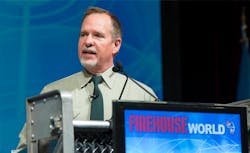FHWorld18: Challenges of the Urban/Wildland Interface
Source Firehouse.com News
The wide scope of new challenges facing the modern fire service and how the unspeakable has in many ways become the new normal are both integral parts of the overall theme at Firehouse World this week in San Diego.
In a sobering keynote address to help open the conference, Robert Baird, the director of the U.S. Forest Service’s Fire and Aviation Program for the Pacific Southwest Region, recognized this new landscape for firefighters while reiterating that challenges may evolve, but priorities remain the same.
"It's sometimes hard to determine what the priorities are," Baird said. "It depends on who you ask. What do friends think you do? What does your mom think you do? What does society think you do? What does your boss think you do? What do little kids think you are? And then there's what you really are? And that's a challenge when we look at what we really do."
"But, in all seriousness, you are heroes to a lot of people, and that's an important thing to recognize."
Baird retired from the Marine Corps in 2012 after 24 years in military service and then served with Cal Fire before joining the U.S. Forest Service in his current role in 2017. Baird currently oversees a regional force of over 5,000 firefighters utilizing hundreds of vehicles and dozens of aircraft.
What drew him to fire service following his military career were the shared core values of both: Duty, honor, sacrifice and commitment to the mission.
"Also the tradition and the history we have in the fire service, and its similar on the wildland side," Baird said.
"These traditions ground us in a selfless act of public service in chaotic and uncertain situations. We go in when other people are evacuated. We put ourselves in harm's way so that others can be protected. We lose our brothers and sisters so that the public can be rescued. But we have to remember that as much as we honor and cherish this rich history, we can't be bound by it."
The need for evolving along with new challenges was evident in 2017 during a horrific spate of wildland incidents in California. The North Bay fires in October and then the massive Thomas fire in December offered a unique perspective on the urban/wildland interface and how those two aspects of firefighting—particularly in California—can no longer be considered mutually exclusive.
"We have a great deal of new challenges, particularly in the wildland/urban interface, but we also have arson, flooding, EMS demands, mass shootings, all-hazards. These things are the new normal," Baird said.
"We're no longer saying the word 'unprecedented.' This is what we're seeing over and over again. And this is what we need to think about and adapt to."
The North Bay fires involved roughly 250 blazes—the largest and most destructive of which was the Tubbs fire. Over 250,000 acres were scorched, 44 civilians were killed and nearly 200 injured, and roughly 9,000 structures were damaged or destroyed.
Baird called it the "deadliest week in the history of California."
"And we had some odd things going on that are the new normal," Baird said. "We had fires going down into agricultural areas, which are not normal, but then we add in mutual-aid challenges. We had hotshots going into vineyards. We also saw structure departments pulling up into the wildland like never before."
Even before firefighters and the state could process the experiences and challenges and learn from them, the Thomas fire erupted in Southern California and burned through 281,000 acres and damaged or destroyed over 1,000 structures.
The damage in sheer dollars from both incidents was in the billions.
"Really a tremendous (amount of) destruction," Baird said of the Thomas fire. "The speed. The complexity. It was wicked. The property destruction and just trying to get around a fire that was growing by tens of thousands of acres. It was amazing."
Through it all, Baird noted that despite the logistical challenges, agencies were able to coordinate a response and mitigate the damage as best they could. With the magnitude of forest destruction across the state creating an incredible fire hazard, these agencies have to continue preparing themselves for working together and being committed to the mission of saving lives and protecting property.
"The devotion, the heroism and the teamwork are consistently observed by a really grateful public," Baird said.
"The key that we need to remember is that it doesn't matter what color the engine is. It can be a red engine, a green engine, a yellow engine. We're all gonna be in this together. And that's an important piece of why you see someone who isn't in a blue uniform here," Baid said, clad in his green Forest Service uniform.
"Wildfire doesn't recognize any jurisdictional boundaries."






